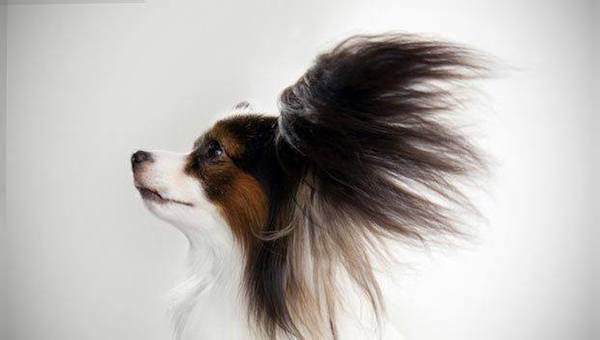
As of now, no gene test exists that will help determine ear type (and in dogs, there are a whole lot of them), but canine genetics research has already revealed genetic variants that are statistically correlated with ear phenotypes. Researchers suspect a currently unknown causal mutation or variant may be somewhere in the vicinity of the tested variant that is showing the statistical correlation.
Even though dog breeds show great diversity in ear morphology, few breeds have much “wiggle room” for what’s acceptable in the breed standard. The Standard Manchester Terrier come to mind as a breed with three options: Naturally erect ears, cropped ears, or button ears, and, of course, a Papillon can be born with signature butterfly ears, or floppier, drop ears known as “moth” ears making the Papillon a Phalene.
Focusing on the latter breed, one theory suggests that the Phalene was the original form of the breed and the erect ears of the Papillon were a product of crossing with spitz-like dogs. We know from 16th century art that these little dogs of the day were drop eared, but by the 19th century, erect eared dogs were showing up on canvases. Both can appear in the same litter.
And then there’s the fringe.
Fringe is the hair growing at the ends of a Papillon’s ears, and as far as we can tell, there are a few things to know about it: As much as the butterfly ears are a signature part of the breed, fringe sets off the ears, and a Papillon can’t have too much of it. It’s rarely, if ever trimmed. That said, not all Paps are genetically programmed to grow the same amount of fringe. Clear red colored Papillons, for instance, don’t not carry as much fringing as a black or tri-colored dog, or even a sable with heavy black overlay. That said, how much fringe a Papillon will have is influenced by its age and coat care (drying the fringes first, for example, will prevent dreaded fringe wrinkles, and when drying ear fringes, one should begin by starting with the hair on the back of the ear first, and working one’s way to the inner side remembering to always go parallel to the direction of hair growth). And you thought fringe was easy.
To read a modern fable on how the Papillon got its ears, click here.
The image of GCH Salatino Entre L’Amour Et Le Devoir (handled to his AKC championship and Grand Championship by Pat Anders) is from Animal Planet. Consider checking out their page on the breed here: http://

SO happy to see my beloved Dede! I will never forget the amazing time I had with this beautiful Papillon! He was very special and I am so lucky to have one of his beautiful sons with me.
Patricia, you ARE lucky, this is an incredibly beautiful dog, and we suspect Dede passed it on to his kids!
He certainly did . Here one of his daughters
Just WOW, Jill. What a stunning little lady….
When choosing a puppy what are signs that he will have good fringe. Not sure what to look for in the ear leather.
Linda, we asked a Papillon breeder for her advice and here is what she says: “Quick answer is look at the pedigree to see if it is packed with curtain ear fringe.
Longer answer — depending on the bloodlines, fringe can become profuse at different stages of growth but rarely can you make a solid prediction on a baby puppy. Hence, just one more reason for avoiding purchase of show prospects at very young ages. Additionally, ear fringe can also skip a generation, so again the knowledge of the pedigree is vital. Lastly, ear fringe can be lost on individual dogs due to lack of proper care (must be kept clean with weekly bathing or more often) or interactions with other dogs that pull or chew their buddy’s fringe during playtime.”
Hope this helps!